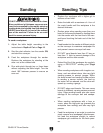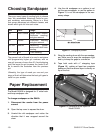
-16-
G0459 12" Drum Sander
Variable Speed
The variable speed knob allows you to increase
the feed rate from 0–15 FPM. The correct speed
to use depends on the type of stock you are using
(hardwood vs. softwood) and the stage of finish
you are at with that workpiece.
As a general rule, a slower feed rate will sand
the surface smoother, but runs the risk of burning
the wood; a faster feed rate will remove material
faster, but runs the risk of overloading the motor.
Use trial-and-error to determine the best settings
for your specific applications.
To adjust the conveyor speed:
1. Start the conveyor.
2. Rotate the variable speed knob (Figure
10) clockwise to increase the feed speed,
or counterclockwise to decrease the feed
speed.
Figure 10. Variable speed knob.
2. Turn the sander ON, start the conveyor (see
Variable Speed
, on this page), and feed the
workpiece into the sander. SLOWLY raise
the conveyor table until the workpiece makes
light contact with the sanding drum. This
is the correct height to begin sanding the
workpiece.
Figure 9. Setting depth of cut.
Depth of Cut
The optimum depth of cut will vary based on
the type of wood, feed rate, and sandpaper grit.
Under most sanding conditions, the depth should
not exceed 0.006" (0.15 mm) (approx.
1
⁄4 turn of
the handwheel). Each full turn of the crank handle
raises the conveyor table approximately 0.027"
(0.69 mm). Attempts to remove too much material
can cause jamming, wood burning, rapid paper
wear or tearing, poor finish, belt slippage, and
motor damage.
To set the depth of cut
:
1. Rotate the crank handle (Figure 9) until the
table is well below the sanding drum, then
raise the table, allowing a gap between the
workpiece and the drum.
Note: When adjusting the table to sand a
thicker workpiece, lower and then raise the
table to remove backlash from the adjust
-
ment mechanism. If the table is lowered too
far, the conveyor belt may rub against the
chain, leaving grease on the belt.


















